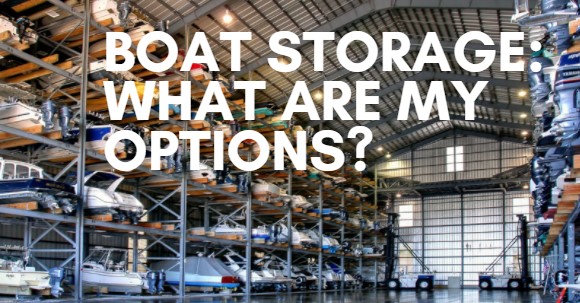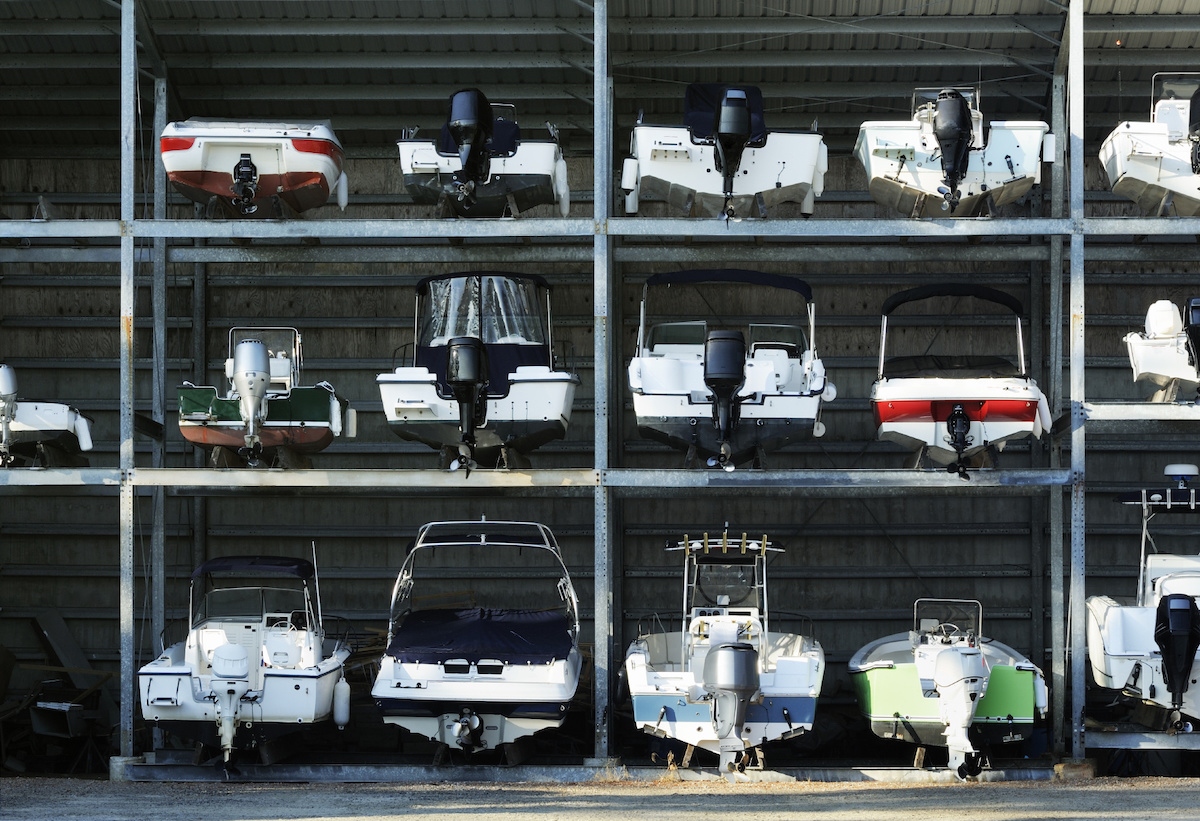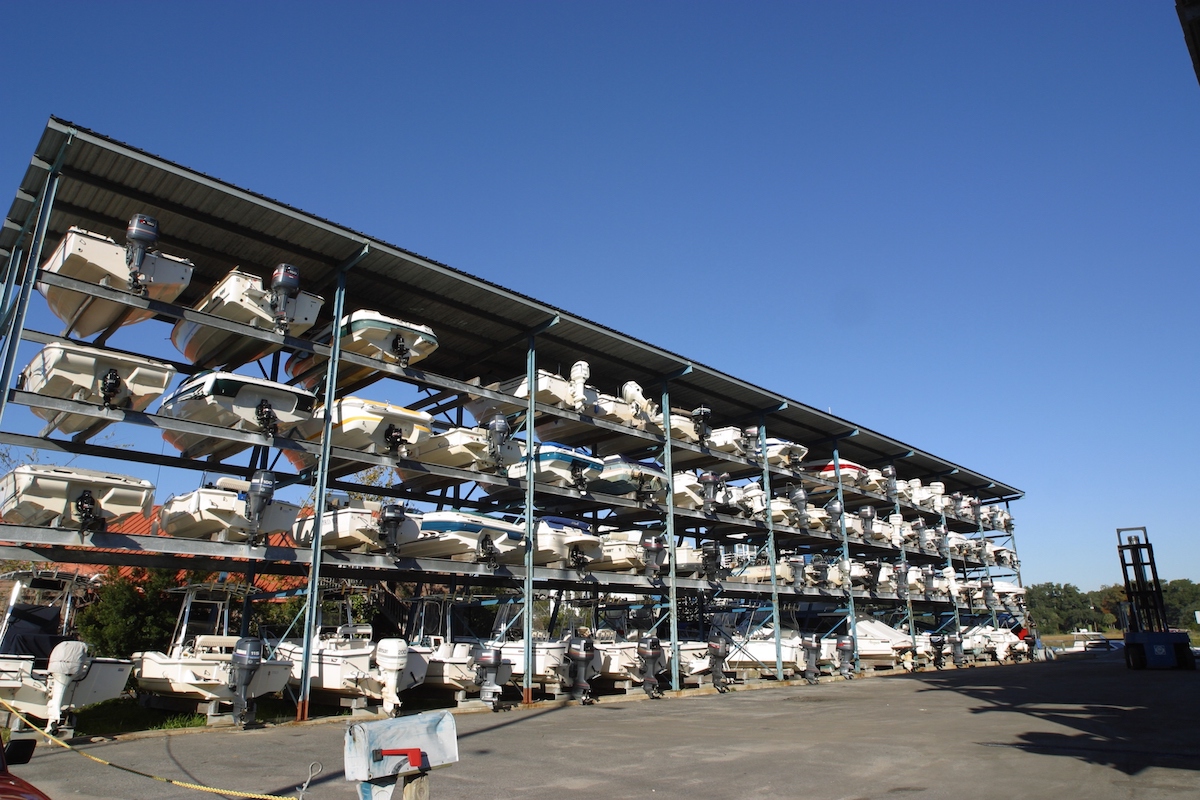
Boat storage both in season and during the winter months is an important consideration for boaters, but the issue raises a lot of questions: how much are boat storage costs? How will I find boat storage near me? Do I need additional boat storage compartments for all my gear, or can it remain on the boat? Article by DiscoverBoating.com.
Let’s start by differentiating between the three main options for boat storage:
- In-Water boat storage
- Dry outdoor boat storage
- Dry boat storage indoors

Place You Can Store Your Boat
Some people store their boats in the water all year long. This is usually considered an acceptable practice in temperate areas where winters are relatively mild, or if you completely winterize your boat in its slip and then add an agitator (ice eater) to keep the water from freezing around the boat during the cold months of the year.
Dry Boat Storage
Dry outdoor boat storage is certainly a more popular option. It’s relatively safe and protective for the boat, and inexpensive compared to most alternatives. Right about now, you’re probably thinking “where is there outdoor boat storage near my lakefront home?” Or if price is a major factor, maybe you’re thinking “where is there cheap boat storage near me?” We can’t answer those questions specifically, because we don’t know where you live. We do, however, have some good news for you: anywhere you find boats, it’s usually pretty easy to locate inexpensive outdoor boat storage. Almost all marinas and boat yards offer it, as do commercial storage facilities. In popular boating areas there are also plenty of fenced lots used for boat storage in the off-season, and for boat trailer storage during the summer months.
Indoor Boat Storage
Indoor boat storage is a more expensive option, however, it also offers the most protection for your boat. Unfortunately, unless you keep your boat in a covered “dry stack” facility (sometimes called a “boatel,” where the boats sit on huge racks inside of a covered building), it can be very difficult to find indoor boat storage. Unless, of course, you have your own garage the boat fits into—in that case, keeping your boat right there at home is a no-brainer. Assuming that’s not an option, however, that same question we asked earlier is sure to come up: “where is indoor boat storage near me?” But in this case it may be a much more difficult question to answer.

Boat Storage Costs
The exact cost of boat storage depends on two main factors: your location, and the size of your boat. Boat storage prices tend to reflect the local economy, so in areas with a low cost of living, the expense will be far less than in a high-rent district. And of course, just how much space your boat takes up has a huge impact on storage costs.
The range can go anywhere from a couple hundred dollars for a small, trailerable boat parked in a fenced field over the winter, to thousands of dollars for indoor boat storage, to tens of thousands for very large boats kept in a wet slip. As a very rough estimate you can use a figure of $50 per foot of boat for minimal indoor or covered boat storage costs, but in more expensive areas, it can cost as much as $200 per foot for a season—or even more. However, keep one other factor in mind. In most cases if you store your boat in an indoor dry stack facility, it lives there year-round. So if you pay for year-round storage you don’t have to worry about paying for a wet slip through the summer months, and your boat stays protected from the elements all year long. Conversely, if you store your boat permanently in a wet slip you won’t have to worry about finding and paying for winter storage separately. Remember, however, that there will still be yearly haul-out fees for maintenance.
One other detail that can affect storage costs is whether or not your boat is on a trailer. If it is, you can often pay a relatively low rate to leave the boat and trailer in a parking area at a local marina that has a boat ramp, year-round. Remember, however, that few marinas will launch and retrieve your boat for you, so you still need to own a tow vehicle capable of pulling the rig to the boat ramp and then back to its resting spot.

Advantages and Disadvantages of the Various Boat Storage Options
For slip holders storing a boat in the water year-round may be more convenient than pulling the boat for dry storage through the winter, but it does carry some risks. If, for example, your marina loses power and the agitator stops working, the hull could become frozen in place and ice damage can occur. So most boat owners opt for dry boat storage during the off-season, especially in parts of the nation with harsh winters. Slip holders who have a lift may also opt to store the boat in place on the lift through the winter. Also, remember that storing your boat in a marina usually comes with some perks. Many have a swimming pool or club house, WiFi, fish-cleaning stations, boat storage boxes mounted on the pier (usually called “dock boxes”) and other amenities that can make your boating adventures even more fun and relaxing.
When it comes to outdoor boat storage, advantages include low expense and easy availability, especially if the boat is sitting on its own trailer. One potential down-side is security, so the facility should be fenced, locked, and have some form of security system or video surveillance. For this reason commercial storage facilities are often a popular option in metropolitan areas. Also, remember that outdoor boat storage requires shrink-wrapping the boat, parking it under a boat storage canopy, or otherwise securely covering it during the winter to prevent water intrusion and weathering.
When it comes to indoor boat storage, expense and availability are the biggest down-sides. Some boaters also don’t like having to plan ahead to use their boat. If you want to use your boat before or after business hours you may need to plan ahead a bit and call ahead of time, so they can fork-lift your boat off the racks and into the water. Finally, some facilities don’t allow boat owners to work on their boats on the site and you may have to pay a pro to do maintenance like oil changes. Otherwise, storing a boat indoors is ideal. The complete protection from weathering can extend a boat’s lifespan astronomically.
FAQs on Storing Your Boat
How much is winter boat storage?
It varies in different parts of the nation and according to your boat’s size. To get a general idea of the potential costs, you can figure on spending somewhere between $50 and $200 per foot of boat indoors and $20 to $50 per foot of boat for outdoor storage, per season.
How much does boat storage cost?
The cost of storing a boat year-round is no different during summer and winter months for most dry stack facilities, and if you store your boat on land through all four seasons, again, the above mentioned prices can give you some guidelines. When storing your boat in the water in a wet slip, the costs will vary by geography and boat size.
How to wrap a boat for winter storage?
The best way to wrap a boat for winter storage is to have it shrink-wrapped by a professional. The blue tarp method helps to protect your boat, but if the tarp isn’t supported and secured just right, leaks, rips, and complete collapses are common.
How much does dry boat storage cost?
As we mentioned earlier there’s a wide variation in cost depending on boat size and geography, however, remember that covered boat storage is more expensive than open storage and indoor dry boat storage costs significantly more than outdoor boat storage. If you’re wondering, “where is covered boat storage near me?” then you have some searching to do, but remember, in parts of the nation where boating is popular there are usually plenty of options.
How to cover a boat for winter storage?
A professional shrink-wrap job is by far the best way to cover a boat for winter storage.
What is dry storage for boats?
Dry storage for boats is generally considered to be any sort of storage where the boat isn’t kept in a wet-slip, in the water.
Re-posted by Scott Freerksen “The Lake Guy”
